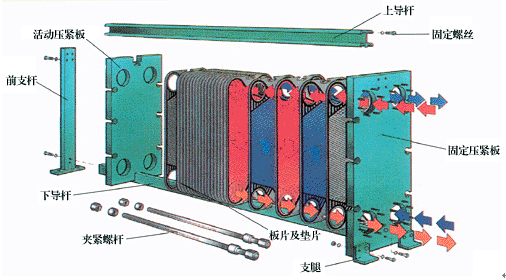

Plate heat exchanger material and performance characteristics
In recent decades, plate heat exchanger has developed rapidly, more and more species, technical performance is getting better and better, more and more widely used. Plate heat exchanger is mainly composed of two parts: frame and plate. The sheet made of various materials is pressed into various shapes with different forms of abrasive tools, and an angle hole is arranged on the four corners of the plate. The periphery of the plate and the hole are sealed with a rubber gasket. The frame is composed of a fixed clamping plate, a movable clamping plate, an upper and a lower guide rods and a clamping bolt. Plate heat exchanger is a plate in the form of superimposed on the fixed compression plate, the middle of the dynamic compaction plate, and then clamp with a clamping bolt.

Gasket is a key component of plate heat exchanger. The working temperature of the plate heat exchanger is essentially the temperature that the gasket can bear. According to the analysis, the length of the sealing perimeter (m) is the heat transfer area (M2) of 6~8 times, (for example: a single plate heat exchanger area of 0.5m2 of the plate, the sealing pad expansion length of about 4m). Plate is thin, rigid, only the use of elastic materials to create gasket, and they can withstand the temperature is not high. Gasket should be sealed compression, the amount of compression should ensure that the groove is not deformed.
1, non adhesive sealing gasket, gasket compared to traditional technology of paste is complicated, time-consuming and inefficient and inconvenient assembly, even may result in harmful components of adhesives, cleaning agent influence the health of human body and lead to plate gasket groove corrosion cracking. Therefore, the application of non adhesive gasket is more and more widely. The general assembly, (for) 1 gasket takes only a few minutes, time and amount of labor respectively pasted to save 80% ~ 95% and 70% pads, especially for field replacement, maintenance costs and downtime losses greatly reduced. The corresponding parts of non stick plate gasket and has special structure shape, both mechanically connected, more varieties, can be divided into "embedded" and "clamping" class two, suitable temperature reaches 165 DEG C, the pressure of 2.5 MPa. ALFA-LAVAL, APV, GEA, the United States ITT and HISAKA and other companies have patented products.
Plate positioning system 2, reliable for the plate and gasket sealing parts accurately and reliably prevent the up and down or left slip, prolong the life of ALFA-LAVAL, APV and gasket, GEA, BN, etc. are used in different plate positioning structure.
3, sealing gasket material and performance evaluation of the weakest link is PHE gasket. Over the years, has become the focus of attention and exploration, has now made some progress in the evaluation of temperature and corrosion resistance materials and their properties.
(1) nitrile rubber (NBR) is generally applicable to 120 DEG C high temperature conditions. The newly developed NBR to 145 DEG C, hydrogenated NBR can reach 160 DEG C; three EPDM (EPDM) used for high temperature of 150 DEG C, EPDM has been increased to 160 DEG C; fluorine rubber (FPM) can be used to 175 DEG C; laminated graphite gasket for temperature can reach 400 DEG C, can be a good way to replace the gasket compressed asbestos fibre.
(2) the gasket is made of rubber or metal block as the core, and the outer layer is made of polytetrafluoroethylene (PTFE) or synthetic material, which can be used in corrosive medium or the temperature limit. HISAKA pioneered the use of PTFE coated NBR gasket, so that the application of PHE in the field than in the past greatly widened, gasket life is longer. ALFA-LAVAL has been used for the double plate welding PHE.
(3) with the development of non adhesive sealing gasket, the formula of the material used for the non adhesive sealing gasket must be changed subtly, which requires the performance is more stable, more durable and more resistant to tearing.
(4) evaluation of the performance of the gasket temperature resistance, there are mainly 2 indicators: the compression temperature and deformation of the permanent deformation. For the new gasket material, the general needs of the ring test and the overall test of plate and gasket, the test time is 5 ~ 40 days. The recommended temperature limit of the gasket should be less than the compression constant curve after considering a certain safety factor.







